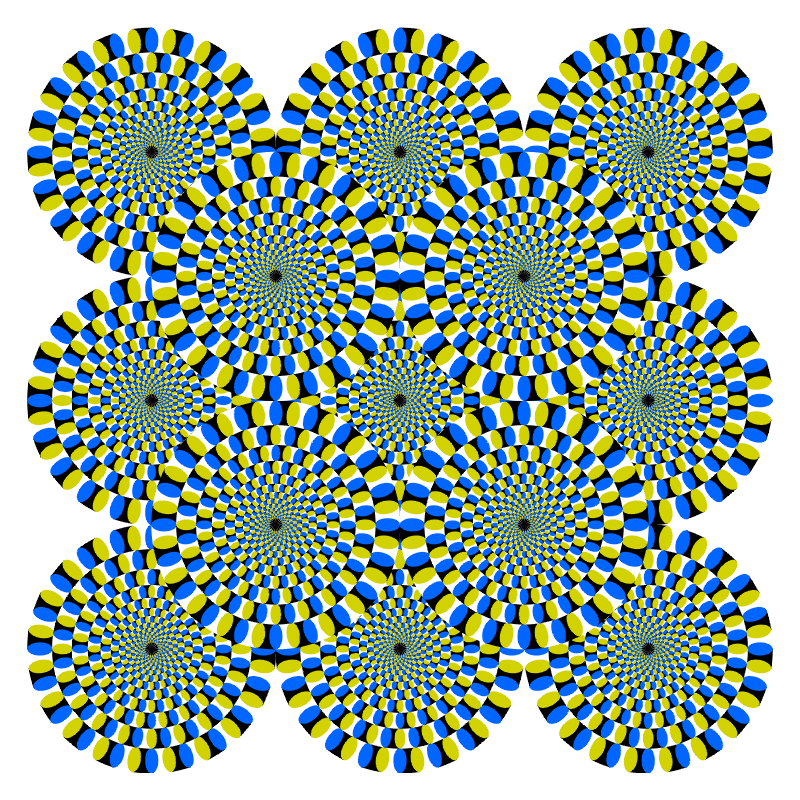
The image above is modified just a little from the original “Rotating Snakes” by Akiyoshi Kitaoka. It demonstrates strong (and beautiful) rotation of the “wheels”, occurring in relation to eye movements. On steady fixation the effect vanishes.
 As Kitaoka & Ashida (2003) describe, asymmetric luminance steps are required. Gregory & Heard (1983) were the first to describe that asymmetric luminance steps cause illusory movement. The picture on the right shows the sequence: …–light(yellow)–white–dark(blue)–black–… The sequence can be manipulated in this variant.
As Kitaoka & Ashida (2003) describe, asymmetric luminance steps are required. Gregory & Heard (1983) were the first to describe that asymmetric luminance steps cause illusory movement. The picture on the right shows the sequence: …–light(yellow)–white–dark(blue)–black–… The sequence can be manipulated in this variant.
We recently (2020) calculated a simple model showing that this illusion is a trivial consequence when you couple motion detectors into arrays with a little non-linearity. The latter, combined with the asymmetric(!) luminance sequence in the Snakes, prevents full cancellation of the local motion signals when saccading over the image. This model also predicts our unexpected finding from 2017 that with certain luminance relations the wheels can turn in the opposite direction (Atala-Gérard & Bach). This can be examined in detail here.
Repeatedly, I was sent such pictures with the assertion that they could be used as a stress test, and some senders were deeply worried. Also I found a web page entitled “test online the level of stress” (I will not link to it) which contains these statements “For a normal person, they should all move at a slow pace, barely rotating. The slower the pictures rotate, the better your ability of handling stress: Allegedly, criminals see stress test images moving and spinning around madly, while seniors and children see them still. …”
This is utter BS! Do not become alarmed. For one, the effect depends on eye movements, and these are known to differ markedly between subjects without relating in a clear-cut way to psychological traits. Further, a few people do not see it at all (could be around 5%, among them a very renowned vision scientist), in spite of appropriate eye movements. There are no actual data showing relations to stress (or age), so don’t distress yourself when you see it rotating strongly or not at all.
After my comments above, this fact check by USA Today arrived at same conclusion. Particularly funny: The false claim attributed »the illusion to “Japanese Psychotherapist Yamamoto Hashima” and claimed interpretation of the image could reveal dangerous exhaustion.”« And the fact check revealed »“Japanese psychotherapist Yamamoto Hashima has nothing to do with this picture,” … “Moreover, Yamamoto Hashima does not really exist.”«
Bach M & Atala-Gérard L (2020) The Rotating Snakes Illusion is a straightforward consequence of non-linearity in arrays of standard motion detectors, i-Perception 11(5), 1–9 [→PDF]
Gregory RL, Heard PF (1983) Visual dissociations of movement, position, and stereo depth: Some phenomenal phenomena. Quarterly Journal of Experimental Psychology 35A:217–237 [PDF]
Kitaoka A, Ashida H (2003) Phenomenal characteristics of the peripheral drift illusion. VISION 15:261–262 PDF
Backus & Oruc 2004 VSS presentation abstract + background material
Conway BR, Kitaoka A, Yazdanbakhsh A, Pack CC, & Livingstone MS (2005) Neural basis for a powerful static motion illusion. J Neurosci 25:5651–5656
Atala-Gérard L, Bach M (2017) Rotating Snakes Illusion – Quantitative analysis reveals a region in luminance space with opposite illusory rotation. i-Perception 8(1):2041669517691779